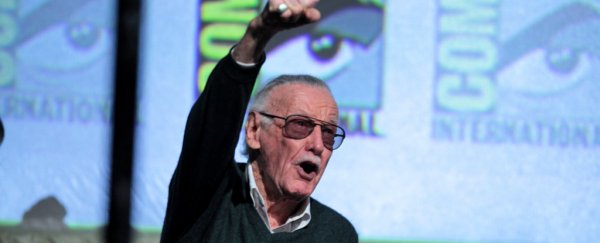Comic-book creator Stan Lee has died, aged 95.
The visionary behind huge swathes of the Marvel Universe and the much-loved superheroes that came with it – Spiderman, Black Panther, The Hulk, Black Widow, and the engineering genius Tony Stark just to name a few – has inspired generations of people with his imagination.
His creations have inspired dozens of research papers, countless inventions, and the occasional billionaire entrepreneur.
But in true delightful, self-depreciating Stan Lee-style, he once called himself "the least scientific person you'll ever know".
In this PBS interview on the science of superheroes back in 2013, Lee said he simply tried to "seem" scientific with his characters - for example, he thought the famous radioactive spider in Spiderman's origin story sounded scientific, as did Hulk getting hit with gamma rays.
"I wouldn't know a gamma ray if I saw it," said Lee. "The whole trick is to make something seem as if you gave it a lot of thought and did a lot of research, but I never had time for research!"
Still, he admits he did always try to make sure science featured heavily in his comics, whether it was well-researched or not - taking a dig at the more far-fetched storylines in rival comics.
"When Superman flies he has no visible means of locomotion … he's just lying in the air," says Lee.
"Not us. At Marvel, we're scientific. I wanted Thor to fly, so he has that hammer, I had him swing it around as fast as a propellor. Then he lets go! Now, it's attached to his wrist, so when the hammer goes shooting off into space, it takes him with it! That's how he flies."
"Incontrovertible scientific fact! And that's the difference between us and the competition."
Although he might make fun of his lack of research, ironically, lot of his ideas on genetic modification and space travel are now actually beginning to play out in the real world.
Take, for example, this chapter in a 2013 American Chemical Society book titled "The Materials Science of Marvel's The Avengers" - which discusses how real-world chemistry could explain the incredible properties of the materials in the Marvel Universe.
More recently, a scientist crunched the numbers and was able to show how Thanos would be strong enough to deadlift The Titanic (he also made real molecular models of the Tesseract).
There was also this engineer's real-life Mjölnir (Thor's hammer), created with electromagnets and fingerprint technology.
And we also had scientists turned into bad-ass role models in the Black Panther movie.
So while he might not have felt like a "scientific person", Lee inspired the science world more than you'd expect – and also shared many traits of great researchers: curiosity, passion, persistence, and imagination.
And we're all aching a little today now that he's left us. Scientists and institutes, including NASA and Neil DeGrasse Tyson, took to Twitter today to mourn the loss of the great visionary mind.
We’re saddened by the loss of @TheRealStanLee, a visionary who created a universe of superheroes and comics. In his honor, here’s a deep-field look into the universe from our @NASAHubble Space Telescope. #Excelsior pic.twitter.com/9UHjyXwIkh
— NASA (@NASA) November 12, 2018
Never underestimate the power of incredible stories. We will always need heroes to show us that maybe, as flawed and hopeless as we are, we still have it in us to save the world. #RIPStanLee
— Katie Mack (@AstroKatie) November 12, 2018
Born before Edwin Hubble discovered the expanding universe, he ultimately created an expanding universe of his own - one of scientifically literate superheroes such as Spider-Man , The Hulk, Iron Man, & Black Panther.
— Neil deGrasse Tyson (@neiltyson) November 12, 2018
Stan Lee RIP: 1922 - 2018
Rest in peace, Stan Lee. The many worlds of imagination & delight you created for humanity will last forever.
— Elon Musk (@elonmusk) November 12, 2018
Outside of the research he inspired, the true legacy that's emerging in the tributes across social media is the way he made people feel as though it was fine to be different - not just fine, but super.
"I used to be embarrassed because I was just a comic book writer while other people were building bridges or going on to medical careers," Lee told The Washington Post in 2010.
"And then I began to realize: entertainment is one of the most important things in people's lives. Without it, they might go off the deep end. I feel that if you're able to entertain, you're doing a good thing."
We couldn't agree more.
And in case you're wondering about the Excelsior! sign off you're seeing all over social media today, that started back in the 1960s when Stan "The Man" Lee started his monthly column in Marvel's Bullpen Bulletins.
He would always end with the catchphrase Excelsior, which is a Latin word meaning "ever upward", which is only fitting for a man who's leaving behind such a stellar legacy on the world.
Rest in peace, Stan Lee. The science world will miss you and your incomparable imagination deeply.
